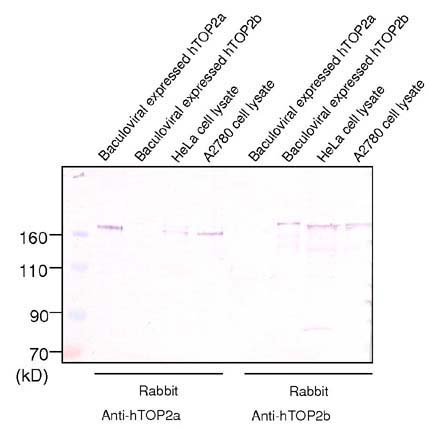|
Human Topoisomerase
IIb
Antibody
(Catalog # AP008)
Specificity:
Rabbit polyclonal antibody against Human
topoisomerase IIb.
Antigen used for immunizations:
Prokaryotic recombinant protein containing the amino acid residues
1111 to 1386 of the human topoisomerase IIb.
Storage Buffer: The
ammonium sulfate-precipitated whole serum is kept
in PBS with 1% BSA and then lyophilized.
Lyophilized antybody should be reconstituted
with 100 ul of H2O before use.

Western blotting:
Working
dilution on Western blotting 1:1000. 60 minutes primary antibody incubates at
25慢 (as shown in Fig).
Recommendations on use:
Immunofluorescence:
Typical working dilution on
frozen sections 1:200. 60 minutes primary
antibody incubates at 25 oC.
Positive controls:
HeLa cells.
Storage and stability:
Store unopened antibody at 4慢 or lower.
Under these conditions, there is no significant loss in product performance
up to one year from the purchase date. The reconstituted antibody is
stable for at least two months when stored at 4慢. For long term storage, it is
recommended that aliquots of the antibody are frozen at -20慢 (frost-free
freezers are not recommended). Repeated freezing and thawing must be avoided.
Prepare working dilutions on the day of use.
Legal consideration:
FOR RESEARCH USE ONLY.
Application:
Topoisomerases are nuclear enzymes
involved in a variety of cellular activities such as
chromosome condensation, DNA replication, transcription, recombination and
segregation at mitosis. Type II DNA topoisomerases manipulate double-stranded
DNA segments. In a reaction coupled to ATP binding and hydrolysis, these enzymes
introduce doublestranded breaks in DNA by transiently cleaving a pair of
complementary DNA strands in one duplex to form an enzyme-operated gate. Another
DNA helix is then passed through the gate. Due to their unique ability to
relieve torsional stress in DNA, they have been assigned roles in a multitude of
nuclear processes such as DNA replication and transcription, as well as
chromosomal segregation and condensation. Eukaryotic topoisomerase II is a
dimeric enzyme, and several dimerisation regions appear to exist based on a
crystal structure obtained from part of yeast topoisomerase II. There are at
least two type II topoisomerases in animal cells: Topoisomerase
IIa
and isomerase IIb. The former
is a cell cycle regulated enzyme of 170 kDa and the latter is not related to
cell cycle phase and is slight larger at 180 kDa.
References:
Chang Y-H, Hwang J, Shang H-F, et al.
Characterization of human DNA Topoisomerase II as an autoantigen regognized by
patients with IDDM. Diabetes. 45: 408-414 (1996).
Holden J A, Rahn M P, Jolles C J, et al.
Immunohistochemical detection of DNA topoisomerase I in formalin fixed, paraffin
wax embedded normal tissues and in ovarian carcinomas. J Clin Pathol: Mol Pathol.
50:
247-253 (1997).
Li TK, Liu LF.
Tumor cell death induced by topoisomerase-targeting drugs. Annu Rev Pharmacol
Toxicol. 41:53-77 (2001).
McLeod H L, Douglas F, Oates M, et al.
Topoisomerase I and II activity in human breast, cervix, lung and colon cancer.
Int J Cancer. 59:
607-611 (1994).
Shero J H, Bordwell B, Rothfield N F, et
al. High titers of autoantibodies to topoisomerase I (Scl-70) in sera from
scleroderma patients. Science.
231:
737-740 (1986).
|





